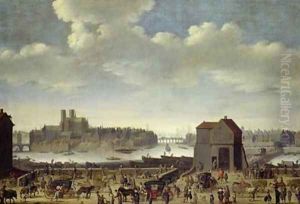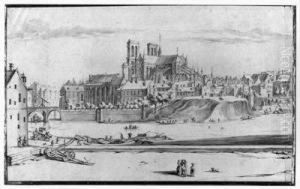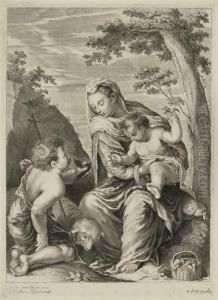Theodor Matham Paintings
Theodor Matham was a notable Dutch engraver, born in 1606 in Haarlem, Netherlands, into a family deeply entrenched in the arts. His father, Jacob Matham, was a renowned engraver and draughtsman, a pupil and stepson of Hendrick Goltzius, who was a towering figure in Dutch art. This lineage placed Theodor in an environment rich with artistic tradition and technical skill from an early age, setting the stage for his eventual contributions to the art world.
Theodor's career is marked by his extensive travels, which significantly influenced his work. In his early years, he ventured to Italy, a journey that was almost a rite of passage for artists of his era, seeking inspiration from the Renaissance masters. During his time in Italy, Theodor worked in Rome and possibly Venice, absorbing the Italianate style, which would later permeate his engravings. His experiences in Italy also provided him the opportunity to connect with other artists and patrons, expanding his influence across Europe.
Upon returning to the Netherlands, Theodor Matham continued to work prolifically, producing engravings that ranged from portraits to mythological scenes, often characterized by a remarkable attention to detail and a deep appreciation for the human form. His works are representative of the Baroque period, embodying the dynamic energy and emotive qualities typical of the era. Matham was not just a replicator of the scenes before him but an interpreter of stories and emotions through his medium.
Matham's legacy is also tied to his family's artistic dynasty, with several of his brothers and descendants following in the engraving tradition. This continuity ensured that the Matham name remained influential in Dutch art for generations. Theodor Matham's death in 1676 did not mark the end of his impact. Today, his engravings are held in high esteem, studied for their technical excellence and expressive depth, and can be found in museum collections and scholarly works focused on the Baroque period and the history of engraving.
Throughout his life, Theodor Matham bridged the worlds of Dutch and Italian art, integrating the stylistic elements of both to create works that were uniquely his own. His ability to capture the essence of his subjects, combined with his technical mastery, cements his place among the notable engravers of the 17th century. His contributions continue to be celebrated by art historians and enthusiasts alike, offering a window into the rich tapestry of Baroque art.






